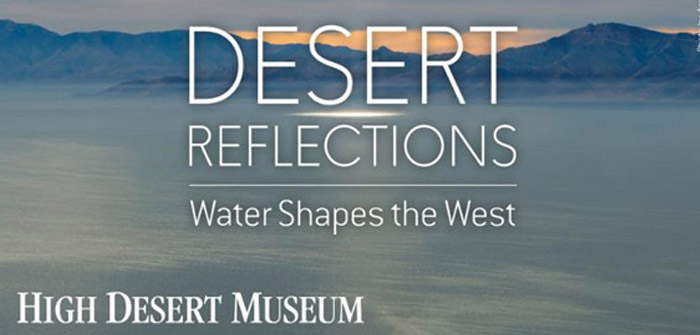A new interdisciplinary, multimedia exhibition exploring the role of water in the region’s past, present and future permeates the space of the High Desert Museum from the present through September 29. Funded by a generous $100,000 grant from the Oregon Community Foundation, the exhibit “weaves together science, history, art and contemporary issues… [to] illuminate how water has shaped the High Desert’s natural, cultural and geological history… [and to] explore how it features prominently in contemporary issues such as resource consumption, Indigenous sovereignty and climate change” (highdesertmuseum.org). Four contemporary Oregon-based artists, Dana Reason, Harmonic Laboratory, Ka’ila Farrell-Smith and Jason Graham, were commissioned to create works for Desert Reflections, artists not typically found in Oregon museums and ones willing to embark on a journey of discovery in concert with the grant program’s risk-taking, boundary-pushing initiatives and the museum’s mission to generate dialogue about important topics in the west.
To spark discussion and inspiration with respect to this complex content area, the group of selected artists, scientific experts and museum personnel went on a three-day field trip to three very important Central Oregon water-related sites: the Pelton Round Butte Dam, the Playa and Paisley Caves at Summer Lake and Ryan Ranch on the Deschutes River Trail. At these inspiring locations, scientific experts explained some of the natural and human-made features and systems while cultural guides offered insights into the natural and cultural resources as well as the ideas and stories surrounding them. Equipped with this abundance of information about our most coveted and essential resource, the artists were then tasked with responding to it in their own unique and creative ways. These responses comprise the artistic component of Desert Reflections: Water Shapes the West.
Below, I introduce two of the four artists and their projects, rendered primarily in their own words and excerpted from their websites, so that you, the to-be viewer of Desert Reflections, can gain some insight into the inspiring and potentially perplexing projects they created before plunging into this watery world of sight, sound and sensation. Part II, appearing in the June issue, will introduce the other two artists and their incredible work.
Dana Reason: (danareason.com)
Dana Reason is a Canadian-born composer, musician and sonic arts researcher and teacher at Oregon State University. She, aided by artists and scientists alike, will contribute one work in three parts, a triptych: She Breathes Water: Installation. Performance. Root Walk. Dana describes her contribution to the exhibit as follows.
She Breathes Water elucidates a real-time visual and sonically interactive landscape. Using video, modular sound sketches and action drawing, She Breathes Water utilizes elements of scientific data on the Ponderosa Pine and data from fire and water behaviors in the High Desert to inform and shape the sound, visuals and music throughout the work. Imagining water as breath, the work situates the story (real and imagined) of water’s journey — below ground during the dry, cold and fire seasons in the high desert region of Oregon. This work has been made possible by the research guidance of forest ecologist, Dr. Gregg Riegel, who introduced me to a community of OSU researchers that has generously shared their data with me for this creation, as well as the curatorial and research team at the High Desert Museum, and from my residency at Playa with undergraduate researcher / artist Paris Myers and students from the OSU Honors College.
She Breathes Water is an asynchronous Triptych. Part One includes a mapped sound walk outside of the High Desert Museum where visitors can listen to the movement of water translated from data of the dry and fire season. Part Two is an interactive performance featuring action drawing by guest visual artist Andrew Myers in concert with technologist Bruce Pennycook (UT Austin) who responds to both fixed musical systems and the dynamic and modular music generated by me, Dana Reason, in real-time. In addition to the aforementioned performers, Part Two also features Jayanthi Joseph on violin, Janie Anderson on english horn and bassoon, and Paris Myers in a video performance from Summerlake. Part Three is a gallery installation of the completed sculptural drawing in conjunction with video and sound.
MOsley WOtta: (mosleywotta.com)
Jason Graham, also known as MOsley WOtta, is many things: a former slam poetry champion for the state of Oregon, hip-hop artist and producer, spoken-word artist, visual artist, educator and Bend’s first Creative Laureate — just to name a few of them. Through this latter honor, Jason serves Bend’s creative community as its official ambassador, a position established through the efforts of the Arts and Culture Alliance, Scalehouse and Bend City Council.
Perhaps best known for his lyrical endeavors, Graham himself has stated that “MOsley WOtta music is specifically designed to celebrate our commonalities and embrace our differences” for “we are all made up mostly of water” (MOsley WOtta, interview with Oregon Art Beat). As a refrain that accompanies his various publications, including his emails and his website, he writes, “I am MOsley WOtta and so are you.”
For Desert Reflections, Jason will present poetry, painting, performance and a landscape installation along the stream behind the High Desert Museum. He describes the work collectively as follows.
W O E: Water Over Everything
What is Water telling us?
MOsley WOtta explores our human desire to cast blame, feel shame and hold guilt regarding our treatment and possession of Water, [a substance that is] a metaphor for life itself. Water has no desire to punish us for our choices. Water has no desire. Water is only ever asking us to accept the consequence of our actions and move forward so we can get back to the ongoing cycle of change. If this means weeping, Water asks that we weep. If this means raging, Water asks us to rage. If this means becoming still, Water asks for our placid nature. Water is always speaking, all ways.

